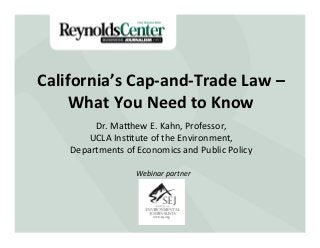
California's Cap and-Trade Law -- What You Need to Know
- 1. California’s Cap-‐and-‐Trade Law – What You Need to Know Dr. Ma'hew E. Kahn, Professor, UCLA Ins8tute of the Environment, Departments of Economics and Public Policy Webinar partner
- 2. California’s cap-‐and-‐trade A program • to limit the state’s carbon emissions Cumula8ve carbon dioxide emissions from G20 and non-‐G20 countries, 1751-‐2006. Photo by Flickr user Carbon Visuals. h'p://www.flickr.com/photos/carbonquilt/3986280325/
- 3. Main Issues Today • Winners and losers: Among those par8cipa8ng in the trading program, which industries have the most to gain, or lose? • What can we learn from the implementa8on of similar laws elsewhere about where likely stories will surface? • What stories should journalists be watching for?
- 5. Excerpt alifornia to return to 1990 levels of greenhouse • AB 32 requires C from ARB Overview gas emissions by 2020. All programs developed under AB 32 contribute to the reduc8ons needed to achieve this goal, and will deliver an overall 15% reduc8on in greenhouse-‐gas emissions compared to the ‘business-‐as usual’ scenario in 2020 if we did nothing at all. • The cap-‐and-‐trade program is a key element in California’s climate plan. It sets a statewide limit on sources responsible for 85 percent of California’s greenhouse gas emissions, and establishes a price signal needed to drive long-‐term investment in cleaner fuels and more efficient use of energy. h'p://www.arb.ca.gov/newsrel/2011/cap_trade_overview.pdf
- 8. Goldilocks • The Air Resources Board (ARB) is well aware that there are interest groups eager to claim that it has “over-‐reached” • If the price of permits is too high, poli8cal backlash • If the price of permits is too low, then no incen8ve to innovate or change behavior!
- 9. Judging Regulatory Success • We do not know the “abatement-‐ cost curves” for any affected en8ty. • In “English”, how costly is it for a given electric u8lity or other polluter to reduce its greenhouse-‐gas emissions? • Do we observe increased investment in “energy-‐efficiency” investments? • Do green jobs emerge? • Do we observe breakthroughs that are unlikely to have taken place in the absence of the cap-‐and-‐trade nudge? Photo by Flickr user CECAR
- 10. Judging Regulatory Failure • The price of electricity for residen8al, industrial and commercial consumers • Goldilocks again! • Leakage: Industries in California that use a lot of electricity shut down factories and move to states without cap-‐and-‐trade. • Prices for consumers rise sharply as regulated en88es pass the costs on to final consumers. Closed steel mill by Flickr user hanjeanwat
- 11. Industries Ranked by Electricity Use Industry NAICS Electricity Index Primary Metal Manufacturing 331 0.816 Paper Manufacturing 322 0.706 TexCle Mills 313 0.503 Nonmetallic Mineral Product Manufacturing Chemical Manufacturing 327 325 0.454 0.402 PlasCcs and Rubber Products Manufacturing 326 0.330 Wood Product Manufacturing 321 0.253 Petroleum and Coal Products Manufacturing 324 0.245 Fabricated Metal Product Manufacturing 332 0.185 PrinCng and Related Support AcCviCes 323 0.169 TexCle Product Mills 314 0.165 Food Manufacturing 311 0.149 Electrical Equipment, Appliance, and Component Manufacturing 335 0.137 Furniture and Related Product Manufacturing 337 0.123 Leather and Allied Product Manufacturing 316 0.110 Machinery Manufacturing 333 0.103 Apparel Manufacturing 315 0.102 Miscellaneous Manufacturing 339 0.096 Beverage and Tobacco Product Manufacturing 312 0.092 TransportaCon Equipment Manufacturing 336 0.086 Computer and Electronic Product Manufacturing 334 0.051 Source: Kahn and Mansur (2011 NBER Working Paper)
- 12. Lessons from Other Na8ons • Bushnell, Chong and Mansur (2012) h'p://www.dartmouth.edu/~mansur/ papers/ bushnell_chong_mansur_carboncost.pdf • Stock Price Event study focused on how cap-‐and-‐trade regula8on affects profits. • In late April 2006, the EU CO2 allowance price dropped by 50%, they track daily returns for 552 stocks from the EUROSTOXX index. • Australia’s carbon tax • Vancouver’s carbon tax • Past U.S success with the sulfur dioxide permit market
- 13. Future Stories • Given that climate change is a global public bad and given that California’s emissions are only a small share of the globe’s total emissions, why is California unilaterally a'emp8ng this effort? • Known unknowns and learning through experimenta8on • Should the rest of the world pay California for running this experiment? • Are permit allowances fair? Why are the pollu8ng industries receiving so many permits for free? Photo by Flickr user NASA • Will the challenges observed in Europe Goddard Photo and Video play out again?
- 14. Why Am I Op8mis8c? • California’s past regulatory success -‐-‐-‐ does this increase the likelihood of cap-‐and-‐ trade success? • California as the “Green Guinea Pig” Photo by Flickr user *~Dawn~*
